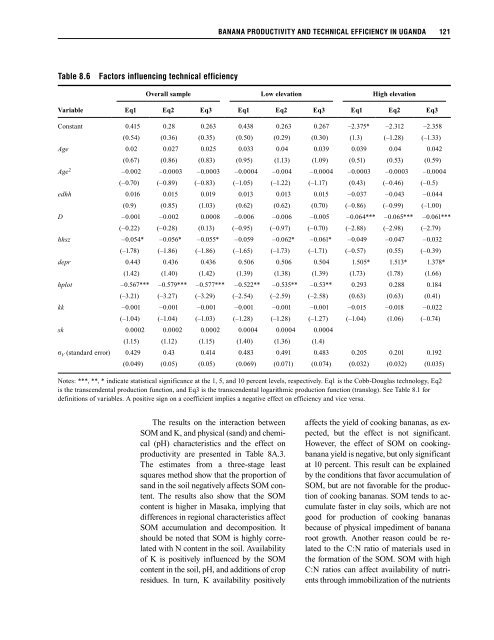An Economic Assessment of Banana Genetic Improvement and ...
An Economic Assessment of Banana Genetic Improvement and ...
An Economic Assessment of Banana Genetic Improvement and ...
You also want an ePaper? Increase the reach of your titles
YUMPU automatically turns print PDFs into web optimized ePapers that Google loves.
BANANA PRODUCTIVITY AND TECHNICAL EFFICIENCY IN UGANDA 121<br />
Table 8.6 Factors influencing technical efficiency<br />
Overall sample Low elevation High elevation<br />
Variable<br />
Eq1 Eq2 Eq3 Eq1 Eq2 Eq3 Eq1 Eq2 Eq3<br />
Constant 0.415<br />
0.28<br />
0.263<br />
0.438<br />
0.263<br />
0.267<br />
–2.375*<br />
–2.312<br />
–2.358<br />
(0.54)<br />
(0.36)<br />
(0.35)<br />
(0.50)<br />
(0.29)<br />
(0.30)<br />
(1.3)<br />
(–1.28)<br />
(–1.33)<br />
Age 0.02<br />
0.027<br />
0.025<br />
0.033<br />
0.04<br />
0.039<br />
0.039<br />
0.04<br />
0.042<br />
(0.67)<br />
(0.86)<br />
(0.83)<br />
(0.95)<br />
(1.13)<br />
(1.09)<br />
(0.51)<br />
(0.53)<br />
(0.59)<br />
Age 2 –0.002<br />
–0.0003<br />
–0.0003<br />
–0.0004<br />
–0.004<br />
–0.0004<br />
–0.0003<br />
–0.0003<br />
–0.0004<br />
(–0.70)<br />
(–0.89)<br />
(–0.83)<br />
(–1.05)<br />
(–1.22)<br />
(–1.17)<br />
(0.43)<br />
(–0.46)<br />
(–0.5)<br />
edhh 0.016<br />
0.015<br />
0.019<br />
0.013<br />
0.013<br />
0.015<br />
–0.037<br />
–0.043<br />
–0.044<br />
(0.9)<br />
(0.85)<br />
(1.03)<br />
(0.62)<br />
(0.62)<br />
(0.70)<br />
(–0.86)<br />
(–0.99)<br />
(–1.00)<br />
D –0.001<br />
–0.002<br />
0.0008<br />
–0.006<br />
–0.006<br />
–0.005<br />
–0.064***<br />
–0.065***<br />
–0.061***<br />
(–0.22)<br />
(–0.28)<br />
(0.13)<br />
(–0.95)<br />
(–0.97)<br />
(–0.70)<br />
(–2.88)<br />
(–2.98)<br />
(–2.79)<br />
hhsz –0.054*<br />
–0.056*<br />
–0.055*<br />
–0.059<br />
–0.062*<br />
–0.061*<br />
–0.049<br />
–0.047<br />
–0.032<br />
(–1.78)<br />
(–1.86)<br />
(–1.86)<br />
(–1.65)<br />
(–1.73)<br />
(–1.71)<br />
(–0.57)<br />
(0.55)<br />
(–0.39)<br />
depr 0.443<br />
0.436<br />
0.436<br />
0.506<br />
0.506<br />
0.504<br />
1.505*<br />
1.513*<br />
1.378*<br />
(1.42)<br />
(1.40)<br />
(1.42)<br />
(1.39)<br />
(1.38)<br />
(1.39)<br />
(1.73)<br />
(1.78)<br />
(1.66)<br />
hplot –0.567***<br />
–0.579***<br />
–0.577***<br />
–0.522**<br />
–0.535**<br />
–0.53**<br />
0.293<br />
0.288<br />
0.184<br />
(–3.21)<br />
(–3.27)<br />
(–3.29)<br />
(–2.54)<br />
(–2.59)<br />
(–2.58)<br />
(0.63)<br />
(0.63)<br />
(0.41)<br />
kk –0.001<br />
–0.001<br />
–0.001<br />
–0.001<br />
–0.001<br />
–0.001<br />
–0.015<br />
–0.018<br />
–0.022<br />
(–1.04)<br />
(–1.04)<br />
(–1.03)<br />
(–1.28)<br />
(–1.28)<br />
(–1.27)<br />
(–1.04)<br />
(1.06)<br />
(–0.74)<br />
sk 0.0002<br />
0.0002<br />
0.0002<br />
0.0004<br />
0.0004<br />
0.0004<br />
(1.15)<br />
(1.12)<br />
(1.15)<br />
(1.40)<br />
(1.36)<br />
(1.4)<br />
σ V (st<strong>and</strong>ard error) 0.429<br />
0.43<br />
0.414<br />
0.483<br />
0.491<br />
0.483<br />
0.205<br />
0.201<br />
0.192<br />
(0.049)<br />
(0.05)<br />
(0.05)<br />
(0.069)<br />
(0.071)<br />
(0.074)<br />
(0.032)<br />
(0.032)<br />
(0.035)<br />
Notes: ***, **, * indicate statistical significance at the 1, 5, <strong>and</strong> 10 percent levels, respectively. Eq1 is the Cobb-Douglas technology, Eq2<br />
is the transcendental production function, <strong>and</strong> Eq3 is the transcendental logarithmic production function (translog). See Table 8.1 for<br />
definitions <strong>of</strong> variables. A positive sign on a coefficient implies a negative effect on efficiency <strong>and</strong> vice versa.<br />
The results on the interaction between<br />
SOM <strong>and</strong> K, <strong>and</strong> physical (s<strong>and</strong>) <strong>and</strong> chemical<br />
(pH) characteristics <strong>and</strong> the effect on<br />
productivity are presented in Table 8A.3.<br />
The estimates from a three-stage least<br />
squares method show that the proportion <strong>of</strong><br />
s<strong>and</strong> in the soil negatively affects SOM content.<br />
The results also show that the SOM<br />
content is higher in Masaka, implying that<br />
differences in regional characteristics affect<br />
SOM accumulation <strong>and</strong> decomposition. It<br />
should be noted that SOM is highly correlated<br />
with N content in the soil. Availability<br />
<strong>of</strong> K is positively influenced by the SOM<br />
content in the soil, pH, <strong>and</strong> additions <strong>of</strong> crop<br />
residues. In turn, K availability positively<br />
affects the yield <strong>of</strong> cooking bananas, as expected,<br />
but the effect is not significant.<br />
However, the effect <strong>of</strong> SOM on cookingbanana<br />
yield is negative, but only significant<br />
at 10 percent. This result can be explained<br />
by the conditions that favor accumulation <strong>of</strong><br />
SOM, but are not favorable for the production<br />
<strong>of</strong> cooking bananas. SOM tends to accumulate<br />
faster in clay soils, which are not<br />
good for production <strong>of</strong> cooking bananas<br />
because <strong>of</strong> physical impediment <strong>of</strong> banana<br />
root growth. <strong>An</strong>other reason could be related<br />
to the C:N ratio <strong>of</strong> materials used in<br />
the formation <strong>of</strong> the SOM. SOM with high<br />
C:N ratios can affect availability <strong>of</strong> nutrients<br />
through immobilization <strong>of</strong> the nutrients
















